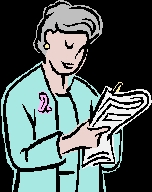Terry M. Gibbs, DO, NCMP
 Each year, over 200,000 women are diagnosed with breast cancer. Methods of treatment including chemotherapy, surgical removal of the ovaries, antiestrogen therapy, and radiotherapy can induce menopause in women who are not yet menopausal. “Induced menopause” can cause intense menopausal symptoms such as hot flashes, vaginal dryness, sleep disturbance, urinary tract problems, painful intercourse, and bone loss can be mild, moderate, or severe.
Each year, over 200,000 women are diagnosed with breast cancer. Methods of treatment including chemotherapy, surgical removal of the ovaries, antiestrogen therapy, and radiotherapy can induce menopause in women who are not yet menopausal. “Induced menopause” can cause intense menopausal symptoms such as hot flashes, vaginal dryness, sleep disturbance, urinary tract problems, painful intercourse, and bone loss can be mild, moderate, or severe.
Most breast cancers are sensitive to the hormone estrogen, so systemic hormone therapy (hormone treatment that circulates through the bloodstream) is not an option. Here are some nonhormonal and lifestyle alternatives for the relief of hot flashes:
1. Avoid hot flash triggers. Let’s start with the simplest option. Every woman is different, so try to identify the things that trigger your hot flashes and adjust your lifestyle—keeping a diary of what you were doing when the hot flash occurred is a good start. Triggers may include: stress, alcohol, caffeine, diet pills, spicy food, hot showers, hot weather, smoking, and overheated bedrooms.
2. Keep your core body temperature as cool as possible. Warm ambient air increases a woman’s core body temperature and makes her more likely to reach the sweating threshold for triggering a hot flash. Conversely, cooler air is associated with a lower incidence of hot flashes. Try this:
- Dress in layers with natural fibers, not synthetic, or wicking fabric that absorbs moisture from the skin.
- Sleep on cotton sheets and with one foot out from under the covers.
- Keep a bottle of cool water at hand.
- Keep a small fan at your desk and on your bedside table or overhead.
- Keep a hand fan with you during the day.
- Take a cool shower before bed.
- Keep a frozen cold pack under your pillow, and turn the pillow often. Some companies make “cool” sheets, pillowcases, pillows, and other products (such as a cooler for the back of the neck) that may benefit some women.
- Invest in air conditioning or a ceiling fan.
3. Maintain a healthy body weight. Several studies have found a higher body mass index (greater than or equal to 27 kg/m2) to be a predictor of hot flash frequency. Peri- and postmenopausal increases in body fat are also associated with increased frequency of hot flashes.
4. Refrain from smoking. Cigarette smoking (both past and current) increases the risk of hot flashes. Passive smoke exposure has also been associated with vasomotor symptoms.
5. Exercise regularly. Less physical activity increases the risk of hot flashes whereas daily exercise is associated with fewer instances. Exercise may also be associated with a shorter overall duration of each hot flash. However, strenuous exercise has been shown to trigger hot flashes in unconditioned women by raising your core body temperature. So don’t overdo it!
6. Practice relaxation techniques. Anxiety has been associated with an increased occurrence, severity, and frequency of hot flashes. Try yoga, meditation, or breathing exercises such as paced respiration (slow, deep, abdominal breaths in through the nose and out through the mouth).
7. Try nonhormonal medications. If the options above aren’t relieving your hot flashes, you may consider these medications with your healthcare provider:
- Blood pressure–lowering medication. Prescription medications such as clonidine (0.05 mg twice daily or 0.1 mg patch once weekly) modify how blood vessels respond to the body’s instruction to release heat quickly.
- Antidepressants. The selective serotonin reuptake inhibitors (SSRIs) Brisdelle (paroxetine; 7.5 mg/d), fluoxetine (20 mg/d), or venlafaxine (37.5-75 mg/d) are options.
- Antiseizure drugs. Gabapentin (300 mg, 3 times daily) is another nonhormonal option for treating hot flashes.
Watch for future articles in Menopause Flashes that will discuss other distressing menopausal symptoms experienced by breast cancer survivors, including vaginal dryness and painful intercourse, increased risk of osteoporosis, and sleep disturbances.
For more information, visit:
Image credit: Copyright © Microsoft. Used with permission.